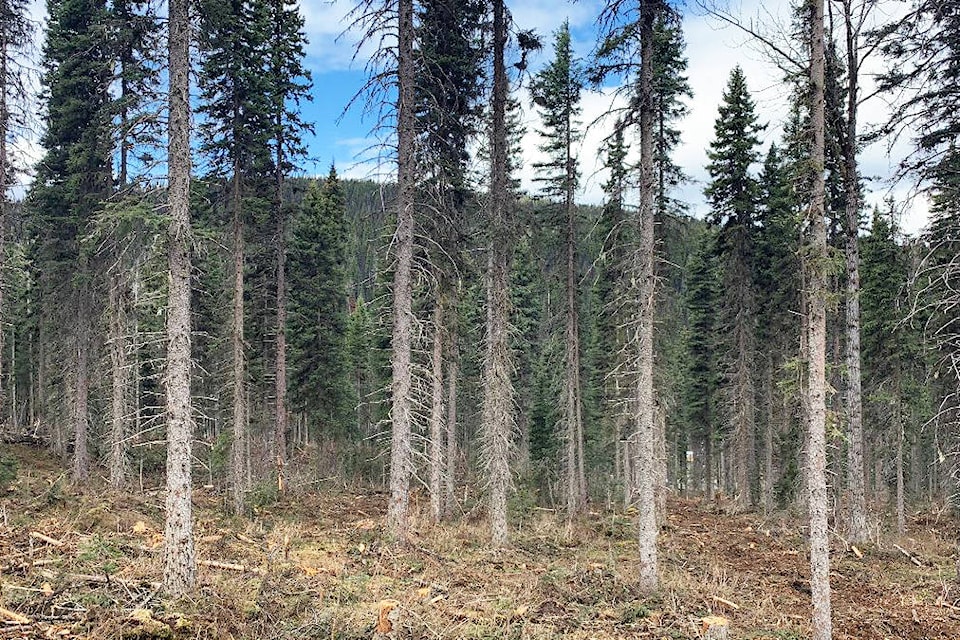In 2017, a wildfire came within12 kilometres of Barkerville Historic Town and Park, the largest living-history museum in western North America.
Since then, a lot of work has gone into protecting the property, which was declared a National Historic Site of Canada in 1924 and a Provincial Heritage Property in 1958, and a complex fuel mitigation project covering a 52-hectare area has just been completed.
“The 2017 wildfires came much too close to the heritage park, and we knew in order to protect this historic town, immediate and strategic measures needed to happen,” Barkerville CEO Ed Coleman said in a press release. “We have been working on fuel mitigation planning for three and a half years, designing the prescriptions and subsequent treatments to protect the site from a wildfire.”
The planning and treatment of this first phase of the fuel mitigation plan presented several challenges due to the high elevation of Barkerville at 4,300 feet, challenging fuel types, and the need to protect heritage and other resource values located in the treatment area. Very few fuel management projects have been done in this type of physical environment, so it was completely new ground for Coleman and his team, according to the release.
“This was, to say the least, a complex fuel management project, but the brainpower and experience that came together to help was incredible,” said Coleman. “We are truly proud of the many, many partners and forestry experts from the Ministry of Forests, Lands, Natural Resource Operations and Rural Development, Heritage Branch, West Fraser Mills, Lhtako Dene Nation, and the Forest Enhancement Society of B.C. (FESBC) who collaborated to develop a successful treatment on the landscape.”
Phase 1 of the $1-million project included treatment of approximately 52 hectares immediately east of Barkerville historic townsite. Work saw a fire access road built with a 10-metre fuel break on either side of the road done by machine. The area beyond was selectively harvested, followed by machine and hand thinning, hand pruning and piling of residual fuel. The residual fuel piles will be chipped or ground and trucked to Cariboo Pulp and Paper for hog fuel. This increases fibre utilization and helps the Province achieve its greenhouse gas reduction targets.
“Thanks to the work of Ed and his team, this has been a great project with outstanding results,” Ray Raatz, FESBC operations manager, said in the release. “In addition to the protection benefits of the treatment, there are new opportunities for historical interpretation and recreational trails in the treated area, and significant operational learnings that can be shared for other fuel mitigation projects conducted in a similar environment. Our society was pleased to help fund such an important project and has approved an additional $75,000 of funding for another phase of treatment.”
At a community meeting last month in Barkerville, Coleman noted the wildfire of 2017 was travelling at 4.5 kilometres a day when it came so close to the park.
“So the fuel management piece is a critical piece of our strategy,” he said. “We worked around all the different heritage values. This is the most complex fuel management project in B.C.’s history, and it’s been successful.”
Coleman says this pilot project is being reviewed, and there are probably 400 more hectares to be managed.
Carrie Chard, Barkerville’s operations and protection services manager, is impressed with how the area has been cleared and how the waste is being used without burning it.
“It’s pretty amazing what they’ve done up there,” she said at the community meeting. “What this has done is taken us back to what it should have been like and making it so it’s accessible. The safety factor is extremely high because you can see what’s going on while they’re dumping [water] or if you’re fighting a fire, you can knock down a break way faster than when the trees are so close together that you can’t see.”
Coleman says the spacing has been cleared anywhere from 30 to 70 per cent in this area, depending on the science of the hill.
“It’s all based on computer modelling of how the fire would move through there, so some sections have more spacing than others, but you’re also trying to be careful of environmental values, animal values, the bird life,” he said. “It’s been really well done. We’ve got good feedback on it.”
Coleman told the meeting attendees that they are also working on adding a second water tank so they can double the size of their capacity, which is about a $1.8-million project.
Jillian Merrick, Barkerville’s preservation and presentation manager, says the site’s new smoking policy will also help protect Barkerville. Starting this year, there is no smoking or vaping permitted in the park at all, and this policy applies to visitors, staff and merchants.
As well, she says everyone on-site who operates a wood stove recently went through a wood stove operators safety course to talk about safe maintenance of the stoves to reduce the likelihood of a fire.
Looking ahead, there are five additional projects that Barkerville Historic Town and Park is looking to undertake, according to the press release.
Jennifer Goad, executive director of Mountain Resorts and Heritage, emphasizes the importance of this proactive work.
“Barkerville is the largest of the Province’s heritage properties and a significant driver of the regional economy,” she said in the press release. “The site provides for over 150 jobs, had a regional economic impact of $20-25 million and is an important site to contextualizing the Province’s resource management history.
“Reducing the risk of wildfire at the site is critical to prevent irreplaceable damage to this provincial heritage asset, allowing its heritage, community, and economic development values to persist for future generations to enjoy.”
